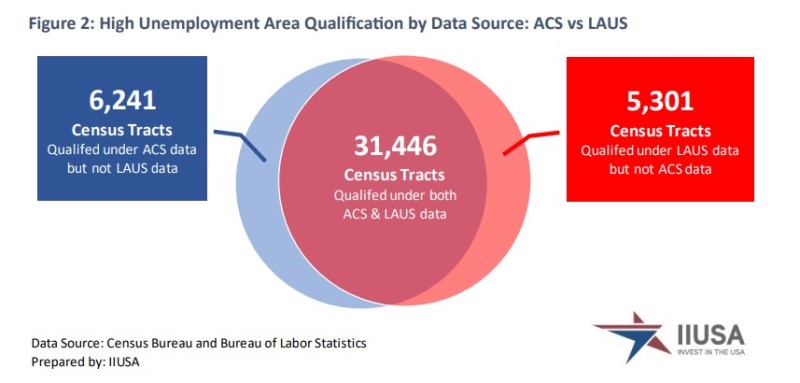
By Anayat Durrani
The latest American Community Survey (ACS) data has revealed some important findings on EB-5 targeted employment areas (TEA).
“The latest ACS data changed the benchmark of qualifying a high unemployment area; therefore, some areas now no longer qualify as a TEA while some other areas present new opportunities for TEA projects,” says Lee Y. Li, director of policy research and data analytics at IIUSA, who authored the report.
The ACS five-year estimates show the national unemployment rate increased by 0.10% to 5.50% between 2017 and 2021. The determination for census tract or contiguous census tracts as an EB-5 high unemployment area has increased to 8.25%. Per the Local Area Unemployment Statistics (LAUS) from the Bureau of Labor Statistics (BLS), the 2022 national average unemployment rate is 5.35%, which places an EB-5 high unemployment area designation for census tracts at 8.03%, according to the report.
Findings show that about 37,690 tracts qualify as high unemployment areas, when using the ACS five year estimates. Some 36,747 census tracts were identified meeting the high unemployment area criteria and qualify as a TEA, per the 2021 annual LAUS data with the census-share methodology.

Which tracts qualify for EB-5 TEA designation?
The report notes the importance of using the “right” data source for TEA determination since not all tracts qualify as a high unemployment area under one data source. The report said nearly 43,000 census tracts, or half of the country, qualify as a high unemployment area employing either the ACS or LAUS data. EB-5 stakeholders can choose which data sources to use, the report said, “that best demonstrate whether their EB-5 project is located within a high unemployment area.”
Li says if an area changes from a TEA to no longer being designated a TEA that the minimum investment amount of EB-5 projects in that area will be $1,050,000 and no longer $800,000.
“EB-5 investors who invested in such projects will no longer enjoy the EB-5 visa numbers that are reserved for TEA projects,” says Li.
The report found that the distribution of high unemployment areas across the country changed and revealed TEA opportunities in different communities, per new unemployment data from ACS.
According to the report, Mississippi overall has the highest percentage of TEA census tracts with 42% of the state’s tracts qualifying for a high unemployment area, 10% qualifying for a rural area, and 32% qualifying for both. The report found that Vermont offers the best opportunities for rural EB-5 projects with 72% of census tracts qualifying as a rural area, the largest share of all 50 states. New Mexico and Nevada offer opportunities for urban TEA projects with 77% and 76% of census tracts qualifying as high unemployment areas.
In “hotbed” areas like California, 70% of the census tracts qualify as a TEA with 67% for New York and 59% for Texas.
When will the new TEA data take effect for EB-5?
The report also noted the impact of Covid-19 and economic factors impacting unemployment in urban areas. Cities like Detroit, MI; Newark, NJ; Cleveland, Ohio; and Los Angeles, CA have more than 95% of census tracts qualifying as high unemployment areas, and these cities have the most urban TEA opportunities among all major cities in the nation, per the report. Some 90% of census tracts in New York, NY and Las Vegas, NV also qualify as high unemployment areas.
Through analysis of the latest ACS data, the report found that the cities of Greensboro, NC and Laredo, TX had double-digit growth in the percentage of city census tracts designated as high unemployment areas offering an opportunity for TEA projects.
“The new ACS data do not impact rural TEAs,” says Li.
The report notes that the current ACS data will remain valid for determining high unemployment areas through the end of the year, but a new data set from LAUS will be released in April 2023.
DISCLAIMER: The views expressed in this article are solely the views of the author and do not necessarily represent the views of the publisher, its employees. or its affiliates. The information found on this website is intended to be general information; it is not legal or financial advice. Specific legal or financial advice can only be given by a licensed professional with full knowledge of all the facts and circumstances of your particular situation. You should seek consultation with legal, immigration, and financial experts prior to participating in the EB-5 program Posting a question on this website does not create an attorney-client relationship. All questions you post will be available to the public; do not include confidential information in your question.








